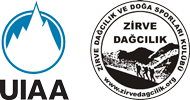| GERİ | Paylaş | 701 |
Primary dangers when using a rope
Bu makaleyi çevirerek ülkemizde ki sınırlı kaynakları geliştirmek adına bize yardımcı olabilirsin. Yapacağınız çeviriler iletişim bilgilerinizle beraber yayınlanacaktır.
Bize ulaşın lütfen.
Warnings
- Read the technical notice before viewing the following techniques.
- It is important to fully understand the information provided in the technical notice before using this complementary information
- Mastering these techniques requires training.
- Consult a professional before attempting to perform these techniques on your own.
Incorrect tie-in, knot incompletely tied or tied in to the wrong place on the harness.
Solution: partner check or mutual verification.


Rope too short.
Solution: always tie a knot at the end of the rope.
And check the length of the route on the topo.

Ground fall due to rope stretch and a bad belay.
Solution: spot, then remain extremely mindful of ground fall potential while the climber is low on the route. Always keep a critical eye on your surroundings (ledges) when considering rope stretch (on lead or on top rope).



Rope behind a leg
This is when the climber falls with the rope behind a leg.



Each year there are multiple incidents in which the rope is cut. For example on sharp rock edges, from rockfall or on fixed carabiners with sharp edges from excessive wear...

Take the time to verify that your rope is compatible with your belay device.
Compatibility obviously depends on the diameter, but also on the treatment, texture, density, flexibility... Two ropes of the same diameter can perform very differently in a belay device. Perform some tests a few meters off the ground, especially with new, slick ropes, or with skinny ropes.
Being tied in does not guarantee your fall will be arrested!
Certain situations demand weighing the pros and cons of whether to use a rope or not. Steep snow slopes are a perfect example...


Kanala abone olmak için
Hedef 200 eğitim videosu
Tırmanış konusunda her hafta yeni bir bilgi için abone olun

